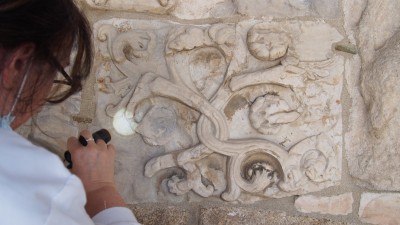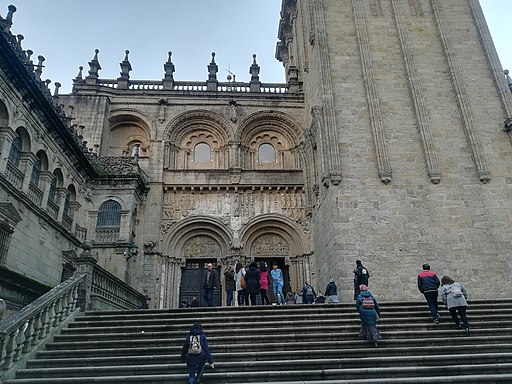
On-going a new campaign of archaeometric study of the marble pieces, now focused on the facade of Platerías
A masterpiece of medieval art and declared a World Heritage Site by UNESCO in 1985, the Cathedral of Santiago de Compostela has, in its Romanesque part, a small but very significant number of sculptural and architectural elements in marble that stand out in an essentially set built in granite.
The Platerias façade, built between 1103 and 1117, stands out for the mixture of original Romanesque reliefs, reliefs from a door that was never built and the Façade of Paradise, as well as some other sculptures from the choir of Maestro Mateo and which were added later.
Researchers Pilar Lapuente Mercadal (Unizar), Silvia González Soutelo (MIAS) and Anna Gutiérrez Garcia-Moreno (ICAC) have carried out an exhaustive visual inspection of the stone components of the frieze and tympanums of the Platerias façade. There has also been a sampling of a selection of the Romanesque reliefs and marble sculptures found there.

The analytical study of the samples obtained has a double objective: the mineralogical and geochemical characterization of each of the pieces and, ultimately, the identification of the place of origin of the marble used for its elaboration.
The analytical study of the samples aims to find out if the marbles used in the façade are only marbles from Galician territory, or if marbles from more distant territories were also used.
Recent studies by this research group have verified that, on the main facade of the Cathedral, the Pórtico de la Gloria, marbles from distant territories and not only Galicians were used (Lapuente et al. 2019).
The exceptional results achieved analytically corroborate, for the first time, the presence of Lusitanian marbles in this building. What were the mechanisms and reasons why these materials reached Santiago? The new campaign is intended to verify whether they were also used in other parts of the Romanesque complex.

The sampling and inspection actions have been possible thanks to the collaboration with the Fundación Catedral and the IPCE (Institute of Cultural Heritage of Spain, Ministry of Culture and Sports), which has facilitated access to the scaffolding placed on the Platerias Cover of the Santiago de Compostela Cathedral to carry out studies prior to its restoration.
The team is satisfied to have been able to work in a unique building and a World Heritage Site, and appreciates the collaboration of the Fundación Catedral and the IPCE.
This study is part of the actions of the project “Marmora Galicia”. It involves the direct continuation of the line of research begun in previous years with the Cathedral of Santiago as the object of study and which began with the analysis of the marble pieces present in the Pórtico de la Gloria (four shafts and the head of an apostle).
On that occasion, pieces from different spaces of the cathedral preserved in the Museo Catedralicio were also analyzed, among which the magnificent twisted columns probably linked to the Portico of Paradise stand out.
Analysis of the marbles of the cathedral is already underway within the framework of the doctoral thesis jointly supervised by the University Bordeaux Montaigne and the University of Zaragoza, by Marie-Claire Savin (IRAMAT-CRP2A UMR 5060 CNRS-UBM) and under the direction of Pilar Lapuente and Rémy Chapoulie.
The project “Marmora Galicia” began in 2012 under the coordination of Silvia González Soutelo and Anna Gutiérrez Garcia-Moreno, and has been linking I+D+i projects funded by the Spanish MICINN and the Laboratoire Sciencies Archéologiques de Bordeaux (program nºANR-10-LABX-52).
More recently, it is linked to the projects “El mensaje del mármol: prestigio, simbolismo y materiales locales en las provincias occidentales del imperio romano entre época antigua y alto-medieval a través del caso de Hispania y Aquitania” (PGC2018-099851-A-I00), led by Anna Gutiérrez Garcia-Moreno (ICAC), and “Sulcato marmore ferro. Canteras, talleres, artesanos y comitentes de las producciones artísticas en piedra en la Hispania Tarraconensis” (PID2019-106967GB-I00), led by Diana Gorostidi (URV-ICAC) and Pilar Lapuente (UniZar-ICAC), recently granted.
The project is also part of the recently recognized as “Red de Investigación” by the Spanish MICINN: “El ciclo productivo del marmor en la península Ibérica desde la antigüedad: extracción, elaboración, comercialización, usos, reutilización, reelaboración y amortización” (RED2018-102722-T), coordinated by Virginia García Entero and which has its own line of research (Group 6), led by Silvia González Soutelo (MIAS/UAM), for the area of the NW of the peninsula.
Pilar Lapuente es profesora titular del Departamento de Ciencias de la Tierra de la Universidad de Zaragoza, e investigadora adscrita en el ICAC.
Silvia González Soutelo és investigadora posdoctoral Tomás y Valiente del Departamento de Prehistoria y Arqueología del Madrid Institute for Advanced Study, MIAS (Universidad Autónoma de Madrid – Casa de Velázquez).
Anna Gutiérrez Garcia-Moreno es investigadora Ramón y Cajal y directora de la Unidad de Estudios Arqueométricos en el ICAC.





